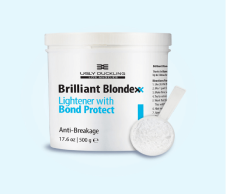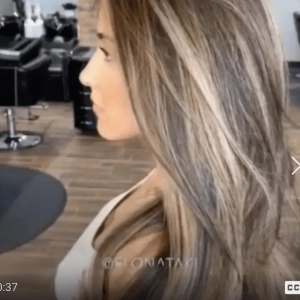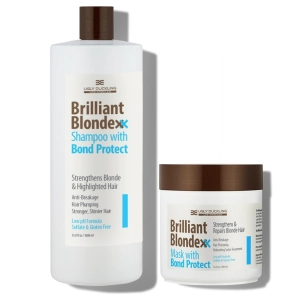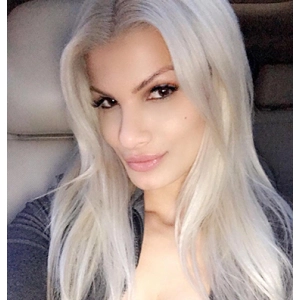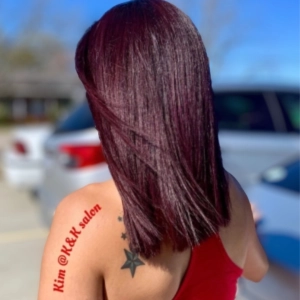Watch video - bleaching dark roots with no damage:
Bleaching hair without damage
When it comes to getting that perfect ash blonde or that vibrant fashion color result, bleaching is very often a necessary process.
No other process can lift the hair as efficiently and as a good quality hair bleach.
But for hairdressers, the key to success when you bleach is maintaining the health of the hair throughout the bleaching process.
In this comprehensive guide, we'll walk you through all the steps you need to take to lift the hair well WITHOUT causing damage.
We'll show you that contrary to what many people, say it is possible to lift as much as 7 or 8 levels in one session - as long as you do it right.
In this article we'll give you some advice about the products you need to use, the tests that you need to perform, and we'll go through all the correct application and processing techniques that you need to earn, as well as after-bleach hair care.
Let's start!
Does bleaching the hair damage it?
By the very nature of how bleach works, the process is inevitably going to place some stress on the hair fiber.
Our job as a hairdresser is to minimise that stress and make sure that the hair is going to be as healthy as possible during and after the bleaching process.
Let's start with what bleach is and what it does.
How does hair bleaching work?
Hair bleach typically contains persulphates.
These persulphates, when combined with the hydrogen peroxide from the developer, open up the hair cuticles, penetrate the hair shaft, and break down the melanin molecules in the hair.
Through this process, the persulphates break open the disulphide bonds in the hair.
This in turn weakens the hair’s structure, making it more porous and receptive to the bleaching agents.
And this in turn makes the hair go lighter. As the persulphates break down the melanin and split disulphide bonds, the natural colour of the hair gradually fades.
The longer the bleach is left on the hair, the lighter the hair becomes, as more melanin is oxidized and removed from the hair.
First, check the quality of your hair
The first thing to do is to check the quality of your client's hair from roots to tips.
Hair that’s already in good condition is going to handle bleaching better than hair that has been fragile and in poor condition.
Very often the root area is virgin hair, In other words it has never been bleached or colored. It's probably in good condition.
However, as you down the shaft towards the mid-lengths, you will find hair that has been colored or bleached in the past.
And here what state it is in will depend on how many times it has gone through these processes and the quality of products that were used.
As for the ends, these are the parts of the hair which are two years old and more.
This hair has been typically been bleached or toned several times, and this will typically be where the hair is thinnest and the most fragile.
Next, develop your bleaching strategy

Dark roots and light ends
Now is the time that you need to assess the level of each part of your client's hair.
Very often, different parts of the hair are at different levels.
Use the chart below to give a level to each part.
The parts that are darker are the parts where you will need to apply the bleach first in order to give it more processing time.
Some parts (for example, a dark root area) will need to be lifted the most. You would apply your bleach there first.
Other parts (for example, the mid-lengths) may just need a light application of 10 minutes to bring them up to the necessary level.
The ends may already be level 10 and not need any bleaching at all.
Make sure you do not apply any bleach there, otherwise you could really compromise the hair quality and end up with broken hair strands.
.jpeg)
Chart of hair color levels. Use this chart to assess the level of each part of your hair
Choosing your bleach - which hair bleach is best?
 (4).jpg)
Brilliant Blondexx Bleach with Bond Protect
For most bleaching situations involving lifts of up to 7 levels, including on scalp applications, we would recommend Brilliant Blondexx Bleach.
It has 3 types of persulfates and it lifts the hair incredibly fast and well.
At the same time, it has Bond Protect built it.
This means that you don't need to add anything to your bleach mixture.
The Bond Protect will build bond in your hair during after the bleaching, ensuring that the hair remains strong.
So strong that you will actually be able to feel the difference.
And thanks to the Bond Protect, the mix that you will get will be incredibly and oil-like: more like a color mix than a bleach mix.
You will find that this will help you with on-scalp applications because it will minimize irritation and itchiness.
Choose the right developer strength
Follow these rules for your developer choice:
For up to 3 levels and on the scalp area, use 20 Vol.
For lifts greater than 3 levels and off-scalp, use 30 Vol.
You should only use 40 Vol in exceptional circumstances.
Get your bleach mix right
The correct mix is 1 part bleach to 2 parts developer. You can either use the scoop provided in your bleach or a weighing scale to get it right.
Experienced colorists will do it by sight. What they try and achieve is a wet, gravy-like consistency.
The bleach needs to be nice and wet, otherwise you won't be drenching and enveloping the hair strands like you need it to do.
At the same time, make sure it is not too wet, otherwise, it will fall off your dye-brush.
How to apply your bleach correctly
With bleach it's all about timing. Always start applying at the part which needs the greatest lift.
Then after than, you need to time when you apply according to how much lift you need.
The goal is to produce an even blank canvas at level 10. That is what you need so that you can then tone.
No part of the hair should get more bleaching time (or less bleaching time) than necessary.
When & how to use foils
Foils are a great idea on long hair, because the foil keeps the heat in and allow you to process faster.
Prepare your foils in advance, pre-cut into strips, because you are not going to get time to do all that once the bleach mix is made.
After around 15- 20 minutes, you need to open up one foil to see how much the hair has lifted.
If at this point a second application is needed, you will need to open up each foil and this time apply it on the open hair.
What color should the hair be when I rinse?
.jpeg)
This is what your hair should look like after bleaching
With bleach you need to start checking from around 15 minutes after application, because how fast the hair is going to lift is going to depend on a host of factors.
The color you are looking for is very very pale yellow - the color of the inside of a banana.
The most common mistake that inexperienced hair stylists make is to rinse too soon. Don't be like that, and try and get a true level 10 bleaching result as in the picture below.
That in turn will make toning far easier.
Applying purple shampoo and mask
Applying purple shampoo and mask during the bleaching process is a great idea. It will help fight any remaining yellow in the hair.
You can either do this after bleaching. Or you can add in purple shampoo and mask during the bleaching process itself.
Ugly Duckling purple shampoo and mask is ideal for this. Both products contain intense purple pigments, plus they are both acid based formulations.
Meaning that they help close the hair after bleaching.
The video below shows an application of purple shampoo during the bleaching process.
Watch video:
Tone the hair

Result after toning with Natural Ash Blonde 010A. Hair by Elona Taki
After bleaching (and even after purple shampoo) it is likely that you will need to tone the hair to produce a finished, sophisticated blonde or fashion color look.
Ugly Duckling has a variety of toners.
We are giving below a couple of level 10 blonde toners.
One is ash based and is called Natural Ash Blonde 010A. It will produce a natural ash blonde result.
The other is purple based and will tend to produce a true platinum blonde result.
Post bleach hair care - take Advantage of hair bonding products

Brilliant Blondexx hair care
Bond Protect products are a great choice after the bleaching process if you are serious about avoiding damage.
Ugly Duckling's Brilliant Blondexx Shampoo and Mask are Bond Product products based around acidic formulations.
They will help make the hair stronger and healthier after bleaching and toning.
Minimise the use of heat
Finally, it is a good idea to use as less heat as you can in your daily hair care routine. Reduce how often you heat style, or minimize the time you spend heat styling by allowing hair to air dry most of the way.
When you do heat style, always use a heat protector.
Conclusion
Bleaching hair doesn't have to be a risky endeavor.
By following these steps, hairdressers and home colorists should be able to achieve stunning results without compromising the health of the hair.
Remember, precision, quality products, and post-bleaching care are the pillars of successful and safe hair bleaching.
So even if this is the first time bleaching for you, embrace the "do it once and do it right" philosophy for beautiful, healthy, and vibrant hair transformations.
Learn how to bleach hair without damage - watch video:
Hair by Ashley Betancourt


